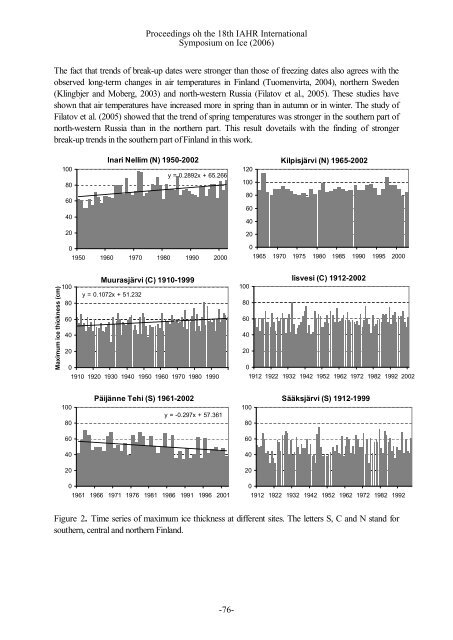LONG-TERM TRENDS IN LAKE ICE COVER IN FINLAND - River Ice
LONG-TERM TRENDS IN LAKE ICE COVER IN FINLAND - River Ice
LONG-TERM TRENDS IN LAKE ICE COVER IN FINLAND - River Ice
You also want an ePaper? Increase the reach of your titles
YUMPU automatically turns print PDFs into web optimized ePapers that Google loves.
Proceedings oh the 18th IAHR InternationalSymposium on <strong>Ice</strong> (2006)The fact that trends of breakup dates were stronger than those of freezing dates also agrees with theobserved longterm changes in air temperatures in Finland (Tuomenvirta, 2004), northern Sweden(Klingbjer and Moberg, 2003) and northwestern Russia (Filatov et al., 2005). These studies haveshown that air temperatures have increased more in spring than in autumn or in winter. The study ofFilatov et al. (2005) showed that the trend of spring temperatures was stronger in the southern part ofnorthwestern Russia than in the northern part. This result dovetails with the finding of strongerbreakup trends in the southern part of Finland in this work.10080Inari Nellim (N) 19502002y = 0.2892x + 65.266120100Kilpisjärvi (N) 196520026040806040202001950 1960 1970 1980 1990 200001965 1970 1975 1980 1985 1990 1995 2000Maximum ice thickness (cm)Muurasjärvi (C) 19101999100y = 0.1072x + 51.2328060402001910 1920 1930 1940 1950 1960 1970 1980 1990Iisvesi (C) 191220021008060402001912 1922 1932 1942 1952 1962 1972 1982 1992 200210080Päijänne Tehi (S) 19612002y = 0.297x + 57.36110080Sääksjärvi (S) 1912199960604040202001961 1966 1971 1976 1981 1986 1991 1996 200101912 1922 1932 1942 1952 1962 1972 1982 1992Figure 2. Time series of maximum ice thickness at different sites. The letters S, C and N stand forsouthern, central and northern Finland.-76-
















